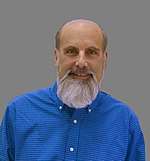Matthew P. Scott
Dr. Matthew P. Scott was the tenth president of the Carnegie Institution for Science. His tenure was September 1, 2014 through December 31, 2017. Scott was Professor of Developmental Biology, Genetics, Bioengineering, and Biology at the Stanford University School of Medicine prior to his Carnegie appointment.
Matthew P. Scott | |
|---|---|
 | |
| Citizenship | United States |
| Alma mater | M.I.T. |
| Known for | Homeobox discovery |
| Spouse(s) | Margaret T. Fuller |
| Scientific career | |
| Fields | Developmental biology |
| Institutions | Stanford University Carnegie Institution for Science |
| Doctoral advisor | Mary Lou Pardue |
| Notable students | Sean B. Carroll, Chris Q. Doe |
Scott did his undergraduate and graduate work at M.I.T., with Prof. Mary Lou Pardue as his Ph.D. thesis advisor. He moved to Indiana University for his postdoctoral work as a Helen Hay Whitney fellow with Profs. Thomas Kaufman and Barry Polisky. After setting up his own lab at the University of Colorado, Boulder, Dr. Scott went to Stanford in 1990 to join the newly formed Department of Developmental Biology, and the Department of Genetics. His research focused on genes that control development, and how damage to these genes leads to birth defects, cancer, and neurodegeneration. He discovered the “homeobox,” an evolutionarily conserved component of many genes that control development. His lab group discovered the genetic basis of the most common human cancer, basal cell carcinoma, and of the most common childhood malignant brain tumor, medulloblastoma.
Scott served as Associate Chair and Chair of the Department of Developmental Biology for a total of six years. He chaired the multidisciplinary Bio-X program at Stanford from 2001-2007 and was Co-chair of the Center for Children’s Brain Tumors. He is a member of the American Academy of Arts and Sciences, the National Academy of Sciences, and the Institute of Medicine, and he served as president of the Society for Developmental Biology. His awards include the Passano Award (1990), the Conklin Medal of the Society for Developmental Biology (2004), and the Pasarow Award in Cancer Research (2013). [1]
While at Stanford University Dr. Scott studied how embryonic and later development is governed by proteins that control gene activity and cell signaling processes.[2] [3]
He independently discovered homeobox genes in Drosophila melanogaster working with Amy J. Weiner at Indiana University.[4][5]
Among his laboratory's many subsequent discoveries, he is recognized for the cloning of the patched gene family and demonstration that a human homolog PTCH1 is a key tumor suppressor gene for the Hedgehog signaling pathway as well as the causative gene for the nevoid basal cell carcinoma syndrome, or Gorlin syndrome.[6][7]
Biography
Scott served on the faculty of the Department of Molecular, Cellular, and Developmental Biology at the University of Colorado starting in 1983. He moved to Stanford University in 1990 to join the faculty of the Department of Developmental Biology and the Department of Genetics. From 2002-2007 he was Chair of Bio-X, Stanford's interdisciplinary biosciences program.[8]
He is married to Stanford developmental geneticist Margaret T. Fuller.
Awards
- 1983 - Helen Hay Whitney postdoctoral fellowship
- 1985 - Searle Scholar[9]
- Conklin Medal, Society for Developmental Biology
- 1999 - Member, National Academy of Sciences
- 2007 - Member, National Institute of Medicine
References
- "President Matthew P. Scott". Archived from the original on 2015-03-18. Retrieved 2015-03-18.
- "Scott lab homepage at Stanford University". Retrieved 2009-04-10.
- "HHMI Scientist Bio: Matthew P. Scott, Ph.D." Retrieved 2009-04-10.
- Scott, M. P. (1984). "Structural Relationships among Genes That Control Development: Sequence Homology between the Antennapedia, Ultrabithorax, and Fushi Tarazu Loci of Drosophila". Proceedings of the National Academy of Sciences. 81 (13): 4115–4119. doi:10.1073/pnas.81.13.4115. PMC 345379. PMID 6330741.
- Laughon, A.; Scott, M. P. (1984). "Sequence of a Drosophila segmentation gene: Protein structure homology with DNA-binding proteins". Nature. 310 (5972): 25–31. doi:10.1038/310025a0. PMID 6330566.
- Hooper, J. E.; Scott, M. P. (1989). "The Drosophila patched gene encodes a putative membrane protein required for segmental patterning". Cell. 59 (4): 751–765. doi:10.1016/0092-8674(89)90021-4. PMID 2582494.
- Johnson, R. L.; Rothman, A. L.; Xie, J.; Goodrich, L. V.; Bare, J. W.; Bonifas, J. M.; Quinn, A. G.; Myers, R. M.; Cox, D. R.; Epstein, E. H. Jr.; Scott, M. P. (1996). "Human homolog of patched, a candidate gene for the basal cell nevus syndrome". Science. 272 (5268): 1668–1671. doi:10.1126/science.272.5268.1668. PMID 8658145.
- "Biography: Matthew Scott". Center for Genetic Medicine, Northwestern University. Archived from the original on 2010-06-20. Retrieved 2009-04-10.
- "Scholar Profile, Matthew P. Scott". Searle Scholars program. Retrieved 2009-04-10.